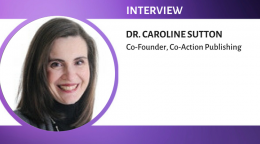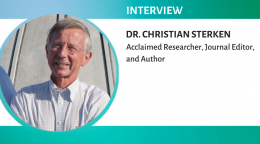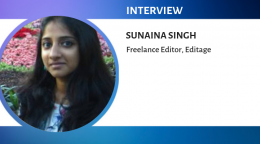Public engagement with science - a collaboration between science and society

Dr. Sarah Iqbal leads the Communications and Public Engagement division at DBT/Wellcome Trust India Alliance, which is an independent public charity that funds research in health and biomedical sciences in India. India Alliance is funded by the Department of Biotechnology (DBT), Government of India and the Wellcome Trust, United Kingdom. With the primary aim of tackling health challenges in India by investing in basic biomedical, clinical, and public health research, India Alliance supports the implementation of relevant policies and interventions that aim to strengthen the research ecosystem in the country, foster interdisciplinary collaboration, and improve the accessibility of science.
Dr. Iqbal is an alumna of the University of Oxford where she completed her Master’s by research and PhD in biochemistry. Following her PhD, she took up a postdoctoral position at the Scripps Research Institute in Florida where she worked on various drug discovery programs. Dr. Iqbal then joined The DBT/Wellcome Trust India Alliance as a public engagement officer and took over the Communication and Public Engagement portfolio. In her current role, she uses her experience as a researcher and her passion of making science more accessible to help drive relevant public outreach initiatives. She also regularly conducts workshops to train researchers on various aspects of grant writing and science communication.
In this conversation, Dr. Iqbal touches upon several interesting facets, including the fascinating idea of how science and art are intricately linked. She also brings up some hard hitting facts about science communication and public engagement –that researchers need training in order to be able to communicate their science effectively and that it may be unfair to hold them solely responsible for effective science communication.
Could you tell us more about your work as the Lead of Communications and Public Engagement?
In my current role, I oversee external communication and public engagement activities in line with the organization’s mission to advance discovery and innovation to improve health. My job involves engagement with various stakeholders, organizing and identifying innovative programs that aim to bridge the science and society gap and finally, cultivating and maintaining new programmatic relationships, nationally and internationally, that empower India Alliance to strengthen the Indian scientific research ecosystem.
You once mentioned that when used together, the disciplines of science and art “open many more doors than they do in isolation.” This sounds interesting. Could you elaborate?
Like a majority of scientists (and artists), I was trained to look at art and science as two different worlds. Deep down I was never convinced about these differences and knew there were connections to be explored. This notion was confirmed and reinforced when I started working on programs that brought together the practice and practitioners of Science and Art. They are more alike than different.
A few hundred years ago, categorizing people as artists and scientists would have been difficult. But today they have been cast into separate silos of knowledge and practice. We are also taught a very rigid definition of these disciplines and that one always has to choose between the two.
Scientific advances and artistic experiences shape our everyday life. In that sense they are indistinguishable to the human experience. In recent times, art has been a useful tool to communicate science, and scientific advances have enhanced artistic practice; together, they enhance our understanding of the world around us.
Could you tell us more about the Khoj initiative?
The Art and Science program that India Alliance supported at Khoj aimed to catalyze interdisciplinary collaboration and experimentation to create avenues for dialogue between the disciplines of Science and Art and in the process make topics of science and health more accessible to the general public. The program gave contemporary artists a platform to explore a scientific or a health topic through their practice; it was an exploration or khoj of science through an artist’s gaze. It also stimulated fascinating discussions on the interactions between science, technology, culture and society, underlining the fact that the practice of art and science are inseparable from society.
To what extent do you think researchers understand the concept of public engagement (i.e., what it entails and why they need to do it)?
Many scientists today do realize the importance of sharing their research with the public. But–perhaps they don’t know the most effective ways to do it. And of course, many would say they don’t have the time to explore in depth the various communication and public engagement methodologies. Also, translational research and certain fields such as conservation and ecology, public health, astronomy, etc. lend themselves more easily to public engagement compared to basic sciences. Generating interest and support for fundamental research is quite challenging and require innovative communication and engagement methods.
In India, we still follow the deficit model of science communication that focuses primarily on disseminating scientific information in an accessible manner. But we have not studied the informational needs of the public and neither have we really mapped who this “public” is that we are communicating to – what do they think of and know about science.
We are yet to adopt the dialogue/engagement model for science communication in which scientists/scientific community actively engage, consult and collaborate with the public to design policies, identify research questions, and carry out research that addresses societal problems. Dr Abhay Bang wonderfully describes three modes of conducting research in this article – research on the people, research for the people and research with the people. In India, we have reached somewhere between on and for. Research with the people is a still a long way away.
In an article you co-authored, you mention that “Public communication of science is not about marketing or public relations; it is about humanising science and cultivating a culture of questioning, reasoning and logic.” How can scientists cultivate such a culture among the public?
Science is not just a collection of facts and figures, it is a way of thinking critically and logically. This was a key take-away for me from my scientific training. Humans are deeply curious by nature and have the inherent ability to question and find solutions to problems they face. These qualities are not unique to people in a particular discipline or profession. Every profession and sector needs to make rational, evidence-based decisions to ensure well-being of people and this planet. The current education system doesn’t nurture these qualities enough.
Not only is it essential to share scientific information with the public but it is also important to convey how scientific research works – and especially to communicate that science can be uncertain, complex, fast changing, and has ethical implications. The COVID-19 crisis has been a wakeup call for us in this regard. Communicating uncertainty and the complex nature of scientific research is no easy task; this requires dedicated and sustained dialogue with the public. After all, one of the major goals of science communication is to enable evidence-based decision-making at all levels of the society. However, sharing facts and figures in the form of evidence alone is not going to be sufficient in promoting critical thinking; involving people in the process and communication of science can perhaps help bring about that change.
These lines by Ramsay Musallam really resonate with me: “If we leave behind this simple role as disseminators of content and embrace a new paradigm as cultivators of curiosity and inquiry, we just might bring a little bit more meaning to the school day and spark their imagination.” I wish we could do more of this. Before anything else, Science needs to be taught well in schools if we are to inculcate a scientific temper. Our initiative, The Explorer Series is a small effort in that direction.
What kind of institutional support do you think researchers need in order to be able to communicate their work to people?
Engaging the public in science is a multi-stakeholder process that requires a multimodal approach. Therefore, I feel that putting the entire onus on the scientist for inculcating scientific temper through science communication and engagement is a tad unreasonable.
For science communication to become a viable and sustainable activity, institutions and funding agencies need to allocate funds, set up formal structures and develop trained personnel to support this. Additionally, the value of engaging the public in research needs to be emphasised early in the scientific training.
The COVID-19 crisis has laid bare our unpreparedness to engage with the public. Any kind of public engagement effort during a crisis, such as the one we are facing, will be successful if a meaningful relationship between science and society already exists.
It’d be great if you could share some quick tips for researchers to engage with the public.
There is no fixed formula as such, only good practices. To begin with, science communication or engagement with public needs to be considered as an integral part of doing research, not as an afterthought or a tick box exercise. I cannot emphasise this enough. The success and impact of any public engagement effort would largely depend on the honesty with which we build this relationship between science and society. The only other thing I would add here is to be mindful of one’s audience, their needs, values, beliefs and prior knowledge. To be able to effectively communicate our ideas it is absolutely essential to know our audience well.
Have you been approached by non-scientists (the public) who wanted to know more about the latest scientific works and how they could affect them?
Yes, all the time! COVID-19 has also suddenly brought to fore that dormant interest in science. On more than one occasion I have been asked about how the research we fund at my organization or more generally in India benefits the average person on the street. More than the complex science the publics want to know how what scientists are working on is impacting their lives. I have also interacted and collaborated with many non-scientists for our public engagement projects where some have shared with me how difficult it is to find a scientist to consult or collaborate with and when they do, the way science is presented to them is incomprehensible. This is also why we are very keen at India Alliance to help scientists become better at communicating their research through our science communication workshops.
Today, more and more people are talking about mental health in academia. What are your thoughts about the current academic culture?
In India, we are slowly but surely waking up to this problem. It is quite ironic that those working at the very institutions that have been established for societal welfare are struggling with mental health issues because of an unhealthy work culture. I also find tokenistic recognition of mental health problematic – it needs to be viewed as a legitimate health concern. Mental well-being and physical health are intricately linked and therefore need to be treated with the same level of urgency and seriousness.
At India Alliance, we have organised as well as supported various programs that aim to raise public awareness on mental health. Recently we supported a thought-provoking series by The Life of Science that explored mental health in Indian science and brought out diverse voices and scenarios in academia that are worrisome and requires our urgent attention. With George Institute for Global Health India, we organised a workshop on Mental Health and Workplace Stress and a Public event around the same theme in Delhi. India Alliance has also been supporting another fantastic initiative, It’s Ok To Talk, that aims to engage with young people about mental health and provide them a safe space to share their experiences with mental health, mental illness and wellbeing. India Alliance is also participating in a global survey by Cactus Communications to better understand mental health challenges in academia.
By now we have conducted and seen enough surveys; there is sufficient data to show that we urgently need to create a healthier and kinder research culture to safeguard the well-being of the scientific enterprise.
Thank you for sharing these great insights, Dr. Iqbal!
Comments
You're looking to give wings to your academic career and publication journey. We like that!
Why don't we give you complete access! Create a free account and get unlimited access to all resources & a vibrant researcher community.







